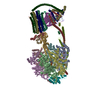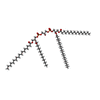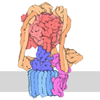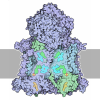[English] 日本語
 Yorodumi
Yorodumi- PDB-9b0x: Artemia franciscana ATP synthase state 2 (composite structure), pH 7.0 -
+ Open data
Open data
- Basic information
Basic information
| Entry | Database: PDB / ID: 9b0x | |||||||||||||||||||||||||||
|---|---|---|---|---|---|---|---|---|---|---|---|---|---|---|---|---|---|---|---|---|---|---|---|---|---|---|---|---|
| Title | Artemia franciscana ATP synthase state 2 (composite structure), pH 7.0 | |||||||||||||||||||||||||||
 Components Components | (ATP synthase ...) x 17 | |||||||||||||||||||||||||||
 Keywords Keywords | MEMBRANE PROTEIN / ATP synthesis / Complex V / mitochondria / oxidative-phosphorylation | |||||||||||||||||||||||||||
| Function / homology |  Function and homology information Function and homology informationATP biosynthetic process / proton-transporting ATP synthase complex / proton-transporting ATP synthase activity, rotational mechanism / proton transmembrane transport / mitochondrial membrane / mitochondrial inner membrane Similarity search - Function | |||||||||||||||||||||||||||
| Biological species |  Artemia franciscana (crustacean) Artemia franciscana (crustacean) | |||||||||||||||||||||||||||
| Method | ELECTRON MICROSCOPY / single particle reconstruction / cryo EM / Resolution: 2.6 Å | |||||||||||||||||||||||||||
 Authors Authors | Mnatsakanyan, N. / Mello, J.F.R. | |||||||||||||||||||||||||||
| Funding support |  United States, 2items United States, 2items
| |||||||||||||||||||||||||||
 Citation Citation |  Journal: Cell Death Differ / Year: 2025 Journal: Cell Death Differ / Year: 2025Title: Cryo-EM structure of the brine shrimp mitochondrial ATP synthase suggests an inactivation mechanism for the ATP synthase leak channel. Authors: Amrendra Kumar / Juliana da Fonseca Rezende E Mello / Yangyu Wu / Daniel Morris / Ikram Mezghani / Erin Smith / Stephane Rombauts / Peter Bossier / Juno Krahn / Fred J Sigworth / Nelli Mnatsakanyan /   Abstract: Mammalian mitochondria undergo Ca-induced and cyclosporinA (CsA)-regulated permeability transition (mPT) by activating the mitochondrial permeability transition pore (mPTP) situated in mitochondrial ...Mammalian mitochondria undergo Ca-induced and cyclosporinA (CsA)-regulated permeability transition (mPT) by activating the mitochondrial permeability transition pore (mPTP) situated in mitochondrial inner membranes. Ca-induced prolonged openings of mPTP under certain pathological conditions result in mitochondrial swelling and rupture of the outer membrane, leading to mitochondrial dysfunction and cell death. While the exact molecular composition and structure of mPTP remain unknown, mammalian ATP synthase was reported to form voltage and Ca-activated leak channels involved in mPT. Unlike in mammals, mitochondria of the crustacean Artemia franciscana have the ability to accumulate large amounts of Ca without undergoing the mPT. Here, we performed structural and functional analysis of A. franciscana ATP synthase to study the molecular mechanism of mPTP inhibition in this organism. We found that the channel formed by the A. franciscana ATP synthase dwells predominantly in its inactive state and is insensitive to Ca, in contrast to porcine heart ATP synthase. Single-particle cryo-electron microscopy (cryo-EM) analysis revealed distinct structural features in A. franciscana ATP synthase compared with mammals. The stronger density of the e-subunit C-terminal region and its enhanced interaction with the c-ring were found in A. franciscana ATP synthase. These data suggest an inactivation mechanism of the ATP synthase leak channel and its possible contribution to the lack of mPT in this organism. | |||||||||||||||||||||||||||
| History |
|
- Structure visualization
Structure visualization
| Structure viewer | Molecule:  Molmil Molmil Jmol/JSmol Jmol/JSmol |
|---|
- Downloads & links
Downloads & links
- Download
Download
| PDBx/mmCIF format |  9b0x.cif.gz 9b0x.cif.gz | 997.9 KB | Display |  PDBx/mmCIF format PDBx/mmCIF format |
|---|---|---|---|---|
| PDB format |  pdb9b0x.ent.gz pdb9b0x.ent.gz | Display |  PDB format PDB format | |
| PDBx/mmJSON format |  9b0x.json.gz 9b0x.json.gz | Tree view |  PDBx/mmJSON format PDBx/mmJSON format | |
| Others |  Other downloads Other downloads |
-Validation report
| Summary document |  9b0x_validation.pdf.gz 9b0x_validation.pdf.gz | 1.6 MB | Display |  wwPDB validaton report wwPDB validaton report |
|---|---|---|---|---|
| Full document |  9b0x_full_validation.pdf.gz 9b0x_full_validation.pdf.gz | 1.7 MB | Display | |
| Data in XML |  9b0x_validation.xml.gz 9b0x_validation.xml.gz | 140.4 KB | Display | |
| Data in CIF |  9b0x_validation.cif.gz 9b0x_validation.cif.gz | 221.8 KB | Display | |
| Arichive directory |  https://data.pdbj.org/pub/pdb/validation_reports/b0/9b0x https://data.pdbj.org/pub/pdb/validation_reports/b0/9b0x ftp://data.pdbj.org/pub/pdb/validation_reports/b0/9b0x ftp://data.pdbj.org/pub/pdb/validation_reports/b0/9b0x | HTTPS FTP |
-Related structure data
| Related structure data |  44061MC  9b3jC  9bpgC M: map data used to model this data C: citing same article ( |
|---|---|
| Similar structure data | Similarity search - Function & homology  F&H Search F&H Search |
- Links
Links
- Assembly
Assembly
| Deposited unit | 
|
|---|---|
| 1 |
|
- Components
Components
-ATP synthase ... , 17 types, 28 molecules 12345678ABCDEFGHIJKLMNOPQRST
| #1: Protein | Mass: 13250.408 Da / Num. of mol.: 8 / Source method: isolated from a natural source / Source: (natural)  Artemia franciscana (crustacean) Artemia franciscana (crustacean)#2: Protein | Mass: 59706.500 Da / Num. of mol.: 3 / Source method: isolated from a natural source / Source: (natural)  Artemia franciscana (crustacean) Artemia franciscana (crustacean)#3: Protein | Mass: 55884.770 Da / Num. of mol.: 3 / Source method: isolated from a natural source / Source: (natural)  Artemia franciscana (crustacean) Artemia franciscana (crustacean)#4: Protein | | Mass: 31976.818 Da / Num. of mol.: 1 / Source method: isolated from a natural source / Source: (natural)  Artemia franciscana (crustacean) Artemia franciscana (crustacean)#5: Protein | | Mass: 17565.455 Da / Num. of mol.: 1 / Source method: isolated from a natural source / Source: (natural)  Artemia franciscana (crustacean) Artemia franciscana (crustacean)#6: Protein | | Mass: 7464.596 Da / Num. of mol.: 1 / Source method: isolated from a natural source / Source: (natural)  Artemia franciscana (crustacean) Artemia franciscana (crustacean)#7: Protein | | Mass: 11974.477 Da / Num. of mol.: 1 / Source method: isolated from a natural source / Source: (natural)  Artemia franciscana (crustacean) Artemia franciscana (crustacean)#8: Protein | | Mass: 29944.416 Da / Num. of mol.: 1 / Source method: isolated from a natural source / Source: (natural)  Artemia franciscana (crustacean) Artemia franciscana (crustacean)#9: Protein | | Mass: 11140.879 Da / Num. of mol.: 1 / Source method: isolated from a natural source / Source: (natural)  Artemia franciscana (crustacean) Artemia franciscana (crustacean)#10: Protein | | Mass: 25422.525 Da / Num. of mol.: 1 / Source method: isolated from a natural source / Source: (natural)  Artemia franciscana (crustacean) Artemia franciscana (crustacean)#11: Protein | | Mass: 24422.471 Da / Num. of mol.: 1 / Source method: isolated from a natural source / Source: (natural)  Artemia franciscana (crustacean) / References: UniProt: Q37708 Artemia franciscana (crustacean) / References: UniProt: Q37708#12: Protein | | Mass: 22563.432 Da / Num. of mol.: 1 / Source method: isolated from a natural source / Source: (natural)  Artemia franciscana (crustacean) Artemia franciscana (crustacean)#13: Protein/peptide | | Mass: 3762.629 Da / Num. of mol.: 1 / Source method: isolated from a natural source / Source: (natural)  Artemia franciscana (crustacean) Artemia franciscana (crustacean)#14: Protein | | Mass: 6351.719 Da / Num. of mol.: 1 / Source method: isolated from a natural source / Source: (natural)  Artemia franciscana (crustacean) / References: UniProt: Q37707 Artemia franciscana (crustacean) / References: UniProt: Q37707#15: Protein | | Mass: 13697.800 Da / Num. of mol.: 1 / Source method: isolated from a natural source / Source: (natural)  Artemia franciscana (crustacean) Artemia franciscana (crustacean)#16: Protein | | Mass: 11236.328 Da / Num. of mol.: 1 / Source method: isolated from a natural source / Source: (natural)  Artemia franciscana (crustacean) Artemia franciscana (crustacean)#17: Protein | | Mass: 9557.997 Da / Num. of mol.: 1 / Source method: isolated from a natural source / Source: (natural)  Artemia franciscana (crustacean) Artemia franciscana (crustacean) |
|---|
-Non-polymers , 4 types, 12 molecules 






| #18: Chemical | ChemComp-ATP / #19: Chemical | ChemComp-MG / #20: Chemical | ChemComp-ADP / | #21: Chemical | |
|---|
-Details
| Has ligand of interest | Y |
|---|---|
| Has protein modification | N |
-Experimental details
-Experiment
| Experiment | Method: ELECTRON MICROSCOPY |
|---|---|
| EM experiment | Aggregation state: PARTICLE / 3D reconstruction method: single particle reconstruction |
- Sample preparation
Sample preparation
| Component | Name: Mitochondrial ATP synthase / Type: COMPLEX / Entity ID: #1-#17 / Source: NATURAL |
|---|---|
| Source (natural) | Organism:  Artemia franciscana (crustacean) Artemia franciscana (crustacean) |
| Buffer solution | pH: 8 |
| Specimen | Conc.: 0.5 mg/ml / Embedding applied: NO / Shadowing applied: NO / Staining applied: NO / Vitrification applied: YES |
| Vitrification | Cryogen name: ETHANE / Humidity: 100 % |
- Electron microscopy imaging
Electron microscopy imaging
| Experimental equipment |  Model: Titan Krios / Image courtesy: FEI Company |
|---|---|
| Microscopy | Model: TFS KRIOS |
| Electron gun | Electron source:  FIELD EMISSION GUN / Accelerating voltage: 300 kV / Illumination mode: FLOOD BEAM FIELD EMISSION GUN / Accelerating voltage: 300 kV / Illumination mode: FLOOD BEAM |
| Electron lens | Mode: BRIGHT FIELD / Nominal magnification: 81000 X / Nominal defocus max: 1700 nm / Nominal defocus min: 1000 nm |
| Image recording | Electron dose: 15.8 e/Å2 / Film or detector model: GATAN K3 BIOQUANTUM (6k x 4k) |
- Processing
Processing
| EM software | Name: PHENIX / Version: 1.21.2_5419 / Category: model refinement |
|---|---|
| CTF correction | Type: PHASE FLIPPING AND AMPLITUDE CORRECTION |
| 3D reconstruction | Resolution: 2.6 Å / Resolution method: FSC 0.143 CUT-OFF / Num. of particles: 232736 / Symmetry type: POINT |
| Atomic model building | Details: Genome annotation and AlphaFold / Source name: Other / Type: integrative model |
 Movie
Movie Controller
Controller

















 PDBj
PDBj






